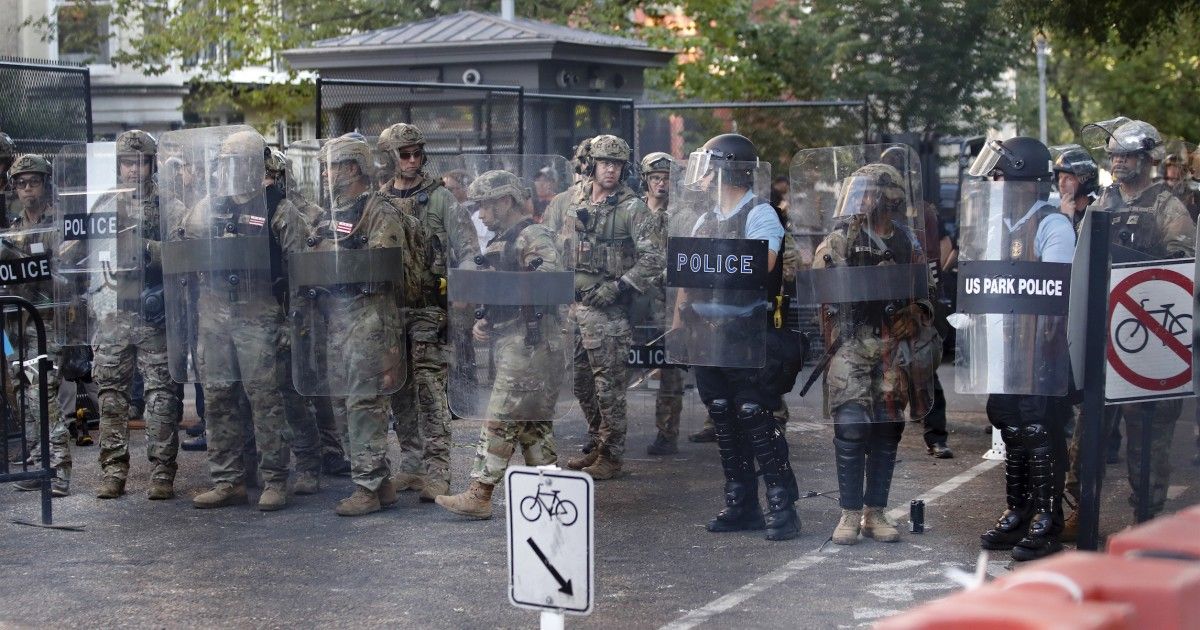Concerns over “civil disturbance” have led the powers-who-be in Washington, DC, to extend the stay of members of the National Guard in the nation’s capital city.
A military occupation in America — who knew.
Military troops are not law enforcement officers. Nor should they be treated as such. The first is designed for war; the second, for fighting crime. Mixing the two can have disastrous results for citizens’ rights.
The mindsets are completely different.
“Police killing more likely in agencies that get military gear,” the Atlanta Journal-Constitution reported in October. “Hardware designed for war exerts subtle pressure on police culture, experts say.”
That’s just common sense.
Police armed with assault-style rifles, decked in black uniforms with thick black vests and topped with military metal helmets, stationed atop armored vehicles and surveilling crowds with night vision goggles — who wouldn’t feel the power while wearing such gear?
“The more [military] equipment a [police] department receives, the more people are shot and killed, even after accounting for violent crime, race, income, drug use and population,” according to the Atlanta Journal-Constitution’s analysis of 651 law enforcement departments in Georgia.
In an infrequent meeting of minds, groups as politically opposite as the American Civil Liberties Union, the Cato Institute and the Charles Koch Institute have nonetheless all pointed out problems with the militarizing of police, not the least of which includes the potential for undue aggression against those in the civilian sector.
“How Militarized Police Can Attract the Wrong Officers,” Cato opined in June.
“Militarization Makes Police More Violent,” Cato followed in August.
“American policing has become unnecessarily and dangerously militarized,” the ACLU wrote in a special 2014 report. “[T]he use of hyper aggressive tools and tactics results in tragedy for civilians and police officers, escalates the risk of needless violence, destroys property and undermines individual liberties.”
How much more so when it’s truly the military in America’s streets, and not simply police dressed like the military.
“The deployment for the entire DC National Guard has been extended until March 31 in anticipation of ‘civil disturbance’ throughout the nation’s capital,” Politico reported, citing a memo that was confirmed by the National Guard. “The memo, signed by D.C. National Guard chief Maj. Gen. William Walker and dated Jan. 25, orders troops to remain on duty at least through the end of March in ‘continued support of District and federal civil authorities during anticipated First Amendment demonstrations and civil disturbance in the District of Columbia.’”
Let the police handle such affairs.
These are not matters for the military.
It’s difficult enough in these militarized police times to keep the boundaries between soldier and civil peace officer clear.
Taking out the middle man — subbing out the police officer dressed in military gear for duly-sworn soldiers properly attired in military gear — is not going to foster peace so much as send strong messages of intimidation.
And perhaps that’s the goal. Perhaps that’s the political end game.
But America is the land of the free, country of the freedom-loving. It’s not a police state. Soldiers don’t belong in the streets doing the work of civil servants. It’s simply not a good look for the nation.
Reprinted with author’s permission from Washington Times.


